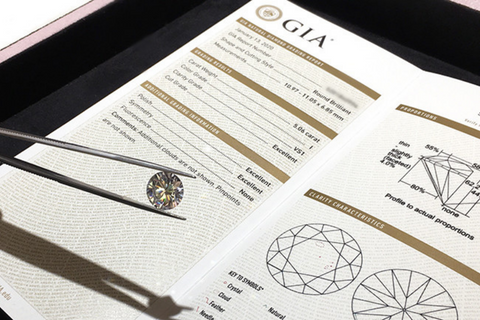The 4 C's of Diamond Quality

Created by Robert M. Shipley, the founder of Gemological Institute of America (GIA) in the early 1940’s, the Four C’s of Diamond Quality is a universal method for assessing the quality of any diamond, anywhere in the world. Shipley was committed to professionalising the Jewellery industry and worked to create universal standards for measuring the quality of gemstones. He set up an institute, GIA, where other jewellers could learn about gemstones and their characteristics. The four C’s were developed as a mnemonic device to help his students remember the four factors that characterise a faceted diamond: cut, colour, clarity and carat weight.
CutDiamonds are renowned for their sparkle. These gems display light like no other! The cut of a diamond does more than just determine its shape (round, oval, marquise, pear, heart, princess, pillow, etc). It determines how well a diamond’s facets interact with light. The magnificent return of light, only possible in a diamond, is a direct reflection of the precise artistry and skilled workmanship required to fashion a stone with ideal proportions, symmetry, and polish.
The final beauty and value of a diamond are directly related to the best possible cut for a specific stone. Of the Four C’s of Diamond Quality, the cut is the most technically complex to analyse. Success of the cut is measured by studying the how a diamond interacts with light to create desirable visual effects such as:
- Brightness: Internal and External white light reflected from a diamond.
- Fire: the scattering of white light into all the colours of the rainbow.
- Scintillation: The amount of sparkle a diamond produces, and the pattern of light and dark areas caused by reflections within the diamond.
Also taken into account in grading a diamond cut are the design and craftsmanship of the final diamond, including the stone’s weight relative to its diameter, its girdle thickness (which affects durability), the symmetry of its facet arrangement, and the quality of the polish on those facets. Adjustments in proportions and pavilion height affect the way in which light is reflected within a diamond. For example, a pavilion depth that is too shallow or deep will allow light to escape from the side of the stone or leak out the bottom. A well cut diamond will direct more light to the crown.
For standard round brilliant cut diamonds, in the D-Z colour scale, the GIA grading contains five grades for diamond cut; Excellent, Very Good, Good, Fair, and Poor, and is the definitive scale for classifying diamond cuts.
ColourThe colour grading of a diamond is actually looking at the absence of colour. The GIA diamond colour scale starts at a D - totally colourless - to a Z. A chemically pure and structurally perfect diamond has no hue. It is like a drop of pure water and is extremely rare. These diamonds consequently have a higher value. The GIA colour grading establishes colour value by measuring the degree of colourlessness. This is done by comparing the stone to masterstones of established colour value under controlled lighting and precise viewing conditions.
Many of the colour distinctions in the scale are so subtle that they are invisible to the untrained eye, but make a big difference in the value of a stone.
ClarityNatural diamonds are created when carbon is exposed to tremendous pressure and extreme heat deep in the earth. This process can result in internal characteristics referred to as “inclusions” and external characteristics called “blemishes”. Diamond clarity is the evaluation of these inclusions and blemishes in a stone and determining the number, size, relief, nature, and position of these, as well as how these affect the overall appearance of the stone. No diamond is perfectly pure, but the closer to purity it gets the higher the clarity grading.
The GIA Diamond Clarity Scale has 6 categories, some of which are divided, for a total of 11 specific grades. These grades are:
- Flawless (FL): No inclusions and no blemishes visible under 10x magnification
- Internally Flawless (IF): No inclusions visible under 10x magnification
- Very, Very Slightly Included (VVS1 and VVS2): Inclusions so slight they are difficult for a skilled grader to see under 10x magnification.
- Very Slightly Included (VS1 and VS2): Inclusions are observed with effort under 10x magnification, but can be characterised as minor.
- Slightly included (SI1 and SI2): Inclusions are noticeable under 10x magnification
- Included (I1, I2 and I3): Inclusions are obvious under 10x magnification which may affect transparency and brilliance.
To the naked eye a VS1 and a SI2 clarity graded diamond may look exactly the same, but these diamonds are very different in terms of overall quality and it is reflected in their value. That is why a professional diamond grading is important and why understanding what diamond clarity means helps you to understand the factors that contribute to diamond quality and price.
Carat WeightSimply put, the carat weight of a diamond measures how much a diamond weighs.
A “carat” is a metric defined as 200 milligrams. Each carat is subdivided into 100 ‘points’. This allows very precise measurements to the 100th decimal place to accurately declare the size of a stone.
Diamond prices increase with carat weight because bigger diamonds are scarcer and more desirable. It should be noted that the final value of a diamond is determined using all four C’s in the grading system. Therefore two diamonds of the same carat weight can have vastly different values, depending on their other characteristics.

So why are diamond gradings important?
All diamonds, natural or lab created, and any size or shape that are gem quality for jewellery use should be professionally graded by an accredited diamond grading specialist. This not only confirms the quality and value of your stone, but along with an origin report confirms that your diamond was responsibly sourced.







Leave a comment